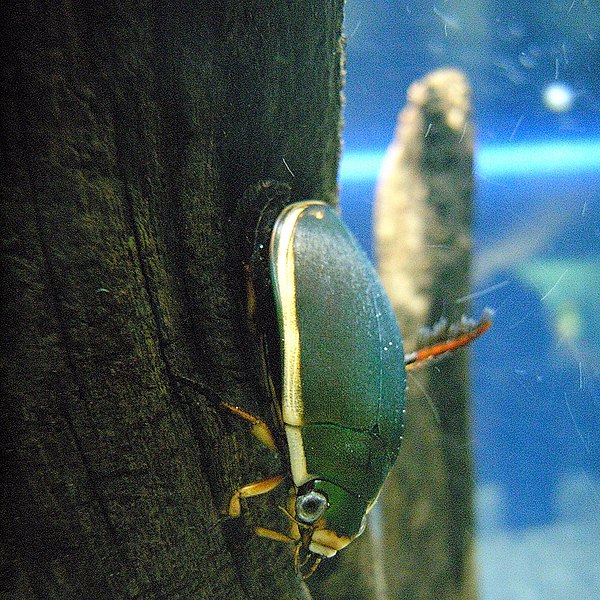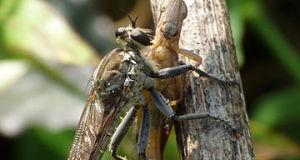 I cannot imagine why aquatic insects have not attracted more interest from invertebrate enthusiasts. Thousands of species, many of which are large and active by day, may be kept in relatively simple aquariums. Aquatic insect exhibits that I have established in zoos and museums are invariably very popular with visitors. From Dragonfly Larvae that flick out extendable “lips” to snare prey to Giant Water Bugs that can tackle small turtles, these other-worldly beings are fascinating to observe, and most are simple to collect. Today I’d like to cover the natural history of 2 species that are sometimes available in the pet trade, the Sunburst or Marbled Diving Beetle (Thermonectes marmoratus) and Green Diving Beetle (Thermonectes sp.). I’ll discuss their captive care in Part 2.
I cannot imagine why aquatic insects have not attracted more interest from invertebrate enthusiasts. Thousands of species, many of which are large and active by day, may be kept in relatively simple aquariums. Aquatic insect exhibits that I have established in zoos and museums are invariably very popular with visitors. From Dragonfly Larvae that flick out extendable “lips” to snare prey to Giant Water Bugs that can tackle small turtles, these other-worldly beings are fascinating to observe, and most are simple to collect. Today I’d like to cover the natural history of 2 species that are sometimes available in the pet trade, the Sunburst or Marbled Diving Beetle (Thermonectes marmoratus) and Green Diving Beetle (Thermonectes sp.). I’ll discuss their captive care in Part 2.
Classification
Diving Beetles are members of the insect order Coleoptera (the Beetles). With over 330,000 species described, Coleoptera is the largest of all animal orders – in fact, one quarter of all known animals are beetles! Curculionidae (the Weevils) is the largest family of beetles. With nearly 45,000 species described thus far (and many, no doubt, as yet unseen) weevils also comprise the world’s largest animal family.
Diving Beetles and their relatives, collectively known as Predacious Diving Beetles, are placed within the family Dytiscidae. There are at least 2,000 species, and they inhabit waters ranging from still vernal ponds to large rivers – several have even colonized extremely hot springs in the western USA and elsewhere.
Physical Description
Sunburst Diving Beetles are, as their name implies, quite beautiful – their oval, smooth-edged carapaces are dotted with gold markings on black wing covers; Green Diving Beetles range from an attractive shade of green to greenish-tan.
The unique oar-shaped rear legs are fringed with hair-like structures to assist in swimming. In contrast to other aquatic insects, Diving Beetles “row” with both rear legs moving simultaneously (other species alternate). They have biting mouthparts (that can pierce human skin!) and average 3/8 – 5/8 inches in length. Special glands emit a milky white liquid that apparently discourages fishes and other predators.
Range and Habitat
Both species are found in western Texas, Arizona, California and Mexico (exact range limits have not been well-studied).
They generally inhabit still or slow moving waters such as ponds, lake margins, swamps and canals.
Both larval and adult Sunburst Diving Beetles, and possibly Green Diving Beetles, aestivate (become dormant) during droughts. Adults may also fly off in search of water at such times.
Diet
 These little terrors are ravenous predators and actively hunt aquatic worms, amphipods, small tadpoles and other insects; terrestrial insects that have fallen into the water and carrion are also taken.
These little terrors are ravenous predators and actively hunt aquatic worms, amphipods, small tadpoles and other insects; terrestrial insects that have fallen into the water and carrion are also taken.
Reproduction
Diving Beetle eggs are attached to aquatic plants. The elongated, aquatic larvae are known as “Water Tigers” and, equipped with out-sized jaws, attack prey much larger than themselves. The larvae pupate on land – in mud at the water’s edge – and return to the water as adults.
An Insect “Aqua-Lung”
Diving Beetles carry an air bubble trapped beneath the wing covers (or elytra) when submerging. Research has recently revealed that this air bubble actually functions as a “lung” of sorts – absorbing additional oxygen from the water and dispersing carbon dioxide!
Further Reading
The San Diego Zoo Website provides much interesting information on aquatic and other beetles.
A video of a related Diving Beetle showing its superb adaptations for life in the water is posted here.
Sunburst Diving Beetle image referenced from wikipedia and originally posted by Ltshears
Predaceous Diving Beetle image referenced from wikipedia and originally posted by OpenCage
 That Reptile Blog – Reptile, Amphibian and Exotic Pet Care and Information
That Reptile Blog – Reptile, Amphibian and Exotic Pet Care and Information



Nice article Frank.
How would I set up a habitat where insects could be in the water and then be able to fly? Are captive water beetles even inclined to fly?I might want to set up something simple but my space is a bit limited. Looking forward to part 2.
Best wishes
noel morales
Hello Noel,
Thanks…I knew you’d see this one! They don’t need to fly, mostly do that just to disperse, but they will try at night so tank need to be covered. I usually keep tank ¾ full, as some species lay in plant stems just at water’s surface, but not critical to have land area. Larvae need to pupate in mud, will use container arranged to stay at surface in ½ filled tank.
Good luck and please keep me posted.
Best regards, Frank Indiviglio.
I actually saw those particular beetles available at hatari inverts. Are filters necessary to maintain ideal conditions for these particular beetles? How large do sunburst and green diving beetles get?
Best wishes
noel morales
Hello Noel,.
Hatari often carries both species and larger ones as well, sometimes giant water bugs. Adults breathe atmospheric oxygen and so technically do not need aeration; however a small filter is preferable to complete water changes in order to maintain water quality. A small corner filter or suction-type bowl filter will be sufficient.
They reach about 5/8 inches in length but appear larger due to rounded shape.
Good luck and please keep me posted.
Best regards, Frank Indiviglio.
I’ve only had marginal luck keeping diving beetles alive in aquariums-let alone breeding them. Perhaps due to species chosen or way they were setup. Sunburst diving beetles and incredibly beautiful just wish I could find them. Have you heard of much success with predacious diving beetles or whirligig beetles?
One neat insect I kept with some success would be water striders. They laid tiny enlongate eggs below the waters edge in the corners of the tank(rocks in the wild I suppose) which hatched into speck sized striders that grew rapidly on meadow plankton and each other. I ended up releasing them into my backyard pond but perhaps due to bullfrogs they failed to persist for long.
Hello Joseph,
Hatari Invertebrates is the best source for these and other insects.
I’ve kept large groups of whirligig beetles in a zoo exhibit with painted turtles and water snakes (visitors sometimes identified them as “tiny baby turtles”!); they are ravenous and put on a real show at feeding time, and survived until Nov-Dec from previous spring (1 season cycle for local species)…I’m certain they bred, but minnows and crayfish likely consumed the larvae. Larger predacious beetles are great aquarium subjects, I’ve raised collected larvae but have not bred them in captivity.
Breeding water striders is quite an accomplishment, congrats; they’ve not done well in exhibits as described above due to competition, water turbulence. When I come across them in the wild, I always toss a small insect to them to watch feeding behavior…
Good luck and please keep me posted.
Best regards, Frank Indiviglio.